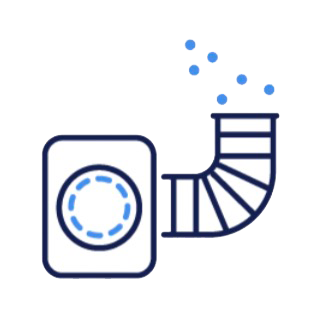Installing your dryer vent hose properly is key to safety, efficiency, and keeping your home lint-free. Many users online report issues like hoses slipping off, kinks reducing airflow, and improper materials on forums like Reddit. This guide provides a simple, step-by-step installation method—plus real-world examples and practical tips.
STEP 1. Tools & Preparation
Before starting, gather these essentials:
- Flathead or Phillips screwdriver
- Metal clamp and aluminum foil tape (not standard duct tape)
- Vacuum or lint brush (optional)
- Utility knife or scissors (if trimming hose)
Unplug the dryer and gently pull it into the room to access the back. Tight spaces are a frequent pain point—one Redditor described how a recessed port and cramped space made aligning the hose nearly impossible (see more).
STEP 2. Connecting the Dryer to the Vent Outlet
Secure the hose firmly to the exhaust port. A common Reddit complaint: “I have hose clamps … but the hose keeps slipping off.” Many people fixed this by using both a clamp and foil tape: “The tape first and clamp second, it is the way.”
STEP 3. Secure with Clamp & Foil Tape
Tighten the metal clamp without crushing the hose. Then wrap a layer of aluminum foil tape around to reinforce the connection. One user learned the hard way that adding duct tape on top of foil tape causes sticky failure—stick with foil tape and a clamp.

STEP 4. Avoid Kinks, Sharp Bends, or Extra Length
Keep the hose short and straight because an accordion-style hose bends, traps lint, and reduces airflow. If trimming is needed, measure accurately and cut with care. Aim for minimal length—just enough to reach the wall vent without extra loops.

Redditor describes this bent setup as "an abomination".
STEP 5. Test Airflow Before Pushing the Dryer Back
Turn on the dryer and check the outdoor airflow. Weak airflow usually indicates a kinked or leaking hose. Adjust the hose before sliding the dryer into its designated spot.
STEP 6. Return the Dryer to Its Position
Slide the dryer back slowly. Avoid crushing or bending the vent hose. If your space is extremely tight, a vent box or magnetic connector can help protect the hose.
STEP 7. Regular Maintenance
- Lint filter: Clean it after every load.
- Vent hose: Inspect every 6 to 12 months. One user reported a hose that was torn nearly all the way around before replacement.
- Exterior vent: Avoid mesh or screens—these can trap lint and lead to a fire.
STEP 8. Choosing the Right Hose Material
Use semi-rigid aluminum or rigid metal duct—they’re durable, fire-safe, and provide smooth airflow. Avoid thin plastic, foil, or flexible accordion types, which are often criticized online for lint build-up and tearing.

Recommended: Hon&Guan 4-inch Semi Rigid Dryer Vent Hose, Clamps and Aluminum Tape Included. All-in-one kit make your choice easier. Click here to see more
FAQ
Q: Can I use duct tape on my dryer vent hose?
A: No. Standard duct tape can’t withstand heat. Use UL-approved foil tape instead.
Q: What’s the best hose for tight spaces?
A: A semi-rigid aluminum hose with a 90° elbow fitting is safest and most space-efficient.
Q: How often should I replace my vent hose?
A: Inspect annually and replace if torn, kinked, or heavily lint-clogged—usually every 3 years.
Conclusion
Proper dryer vent hose installation isn’t complicated, but small mistakes can cause airflow issues or even fire risks. By following this step-by-step method, using safe materials, and learning from real user experiences, you’ll keep your dryer running efficiently and your home safe.



